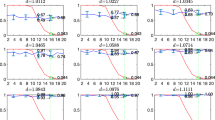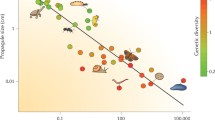Abstract
Some theory pertaining to the genetic variability of haplo-diploid species is examined. Genetic variability due to wholly deleterious alleles is reduced in haplo-diploid species compared with species with both sexes diploid, but a random numbers experiment suggests that there is no a priori reason to believe haplo-diploidy reduces the likelihood of balanced polymorphism.
Similar content being viewed by others
References
Arkin H. & R. R. Colton (1963). Tables for statisticians. 2nd ed. Barnes and Noble, New York.
Askew R. R. (1968). Considerations on speciation inChaleidoidea (Hymenoptera).Evolution 22: 642–645.
Bodmer W. F. & A. W. F. Edwards (1960). Natural selection and the sex ratio.Ann. Human Genet. 24: 239–244.
Crozier R. H. (1969a). Cytotaxonomic studies on some Australian Dolichoderine ants (Hymenoptera: Formicidae).Caryologia 21: 241–259.
Crozier R. H. (1969b). Chromosome number polymorphism in an Australian ponerine ant.Can. J. Genet. Cytol. 11: 333–339.
Hille W. (1965a). Inbreeding depression in an arrhenotokous mite.Entomol. Exp. Appl. 8: 299–304.
Helle W. (1965b). Population genetics of arrhenotokous mites.Boll. Zool. Agrar. Bachiocultura. II 7: 219–226.
Helle W. (1968). Genetic variability of photoperiodic response in an arrhenotokous mite (Tetranychus urticae).Ent. Exp. Appl. 11: 101–113.
Johnson F. M., H. E. Schaffer, J. E. Gillaspy & E. S. Rockwood (1969). Isozyme genotype-environment relationships in natural populations of the harvester ant,Pogonomyrmex barbatus, from Texas.Biochem. Genet. 3: 429–450.
Li C. C. (1955). Population genetics. Chicago Univ. Press, Chicago.
Li C. C. (1967). Genetic equilibrium under selection.Biometrics 23: 397–484.
McEnroe, W. D. (1969). Free genetic variability in the two-spotted spider miteTetranychus urticae K.(Acarina: Tetranychidae). Massachusetts Agric. Exp. Sta., U. Massachusetts Waltham Field Sta.,Exp. Bull. No.580.
McEnroe W. D. & J. A. Naegele (1968). The coadaptive process in an organophosphorus-resistant strain of the two-spotted spider mite,Tetranychus urticae.Ann. Entomol. Soc. Amer. 61: 1055–1059.
Mestriner M. A. (1969). Biochemical polymorphism in bees (Apis mellifera ligustica).Nature 223: 188–189.
Rothenbuhler W. C., J. M. Kulincevic & W. E. Kerr (1968). Bee genetics.Ann. Rev. Genet. 2: 413–438.
Selander R. K., S. Y. Yang & W. G. Hunt (1969). Polymorphism in esterases and hemoglobin in wild populations of the house mouse (Mus musculus).Studies in Genetics 5 Univ. Texas Publ. 6918: 271–338.
Suomalainen E. (1962). Significance of parthenogenesis in the evolution of insects.Ann. Rev. Entomol. 7: 349–366.
White M. J. D. (1954). Animal cytology and evolution. Cambridge Univ. Press, Cambridge.
Author information
Authors and Affiliations
Rights and permissions
About this article
Cite this article
Crozier, R.H. On the potential for genetic variability in haplo-diploidy. Genetica 41, 551–556 (1970). https://doi.org/10.1007/BF00958934
Received:
Issue Date:
DOI: https://doi.org/10.1007/BF00958934




